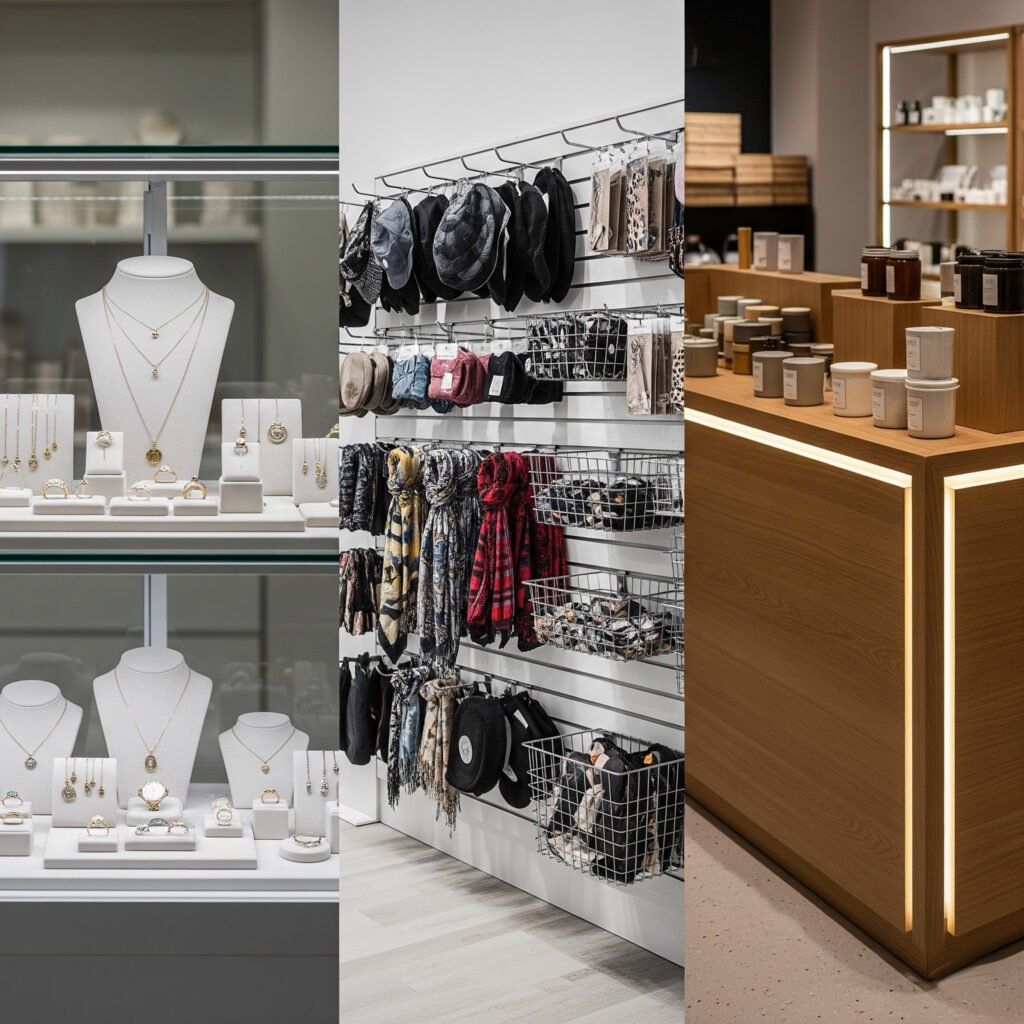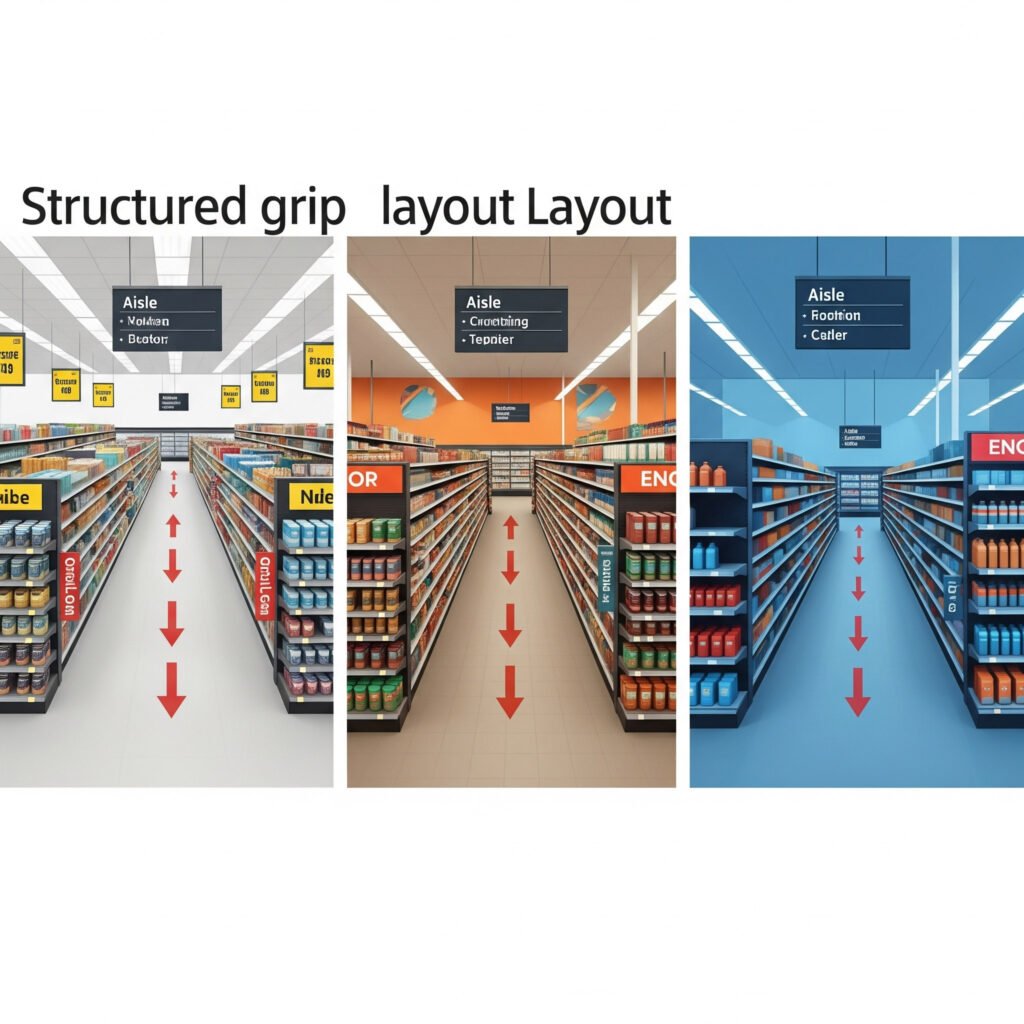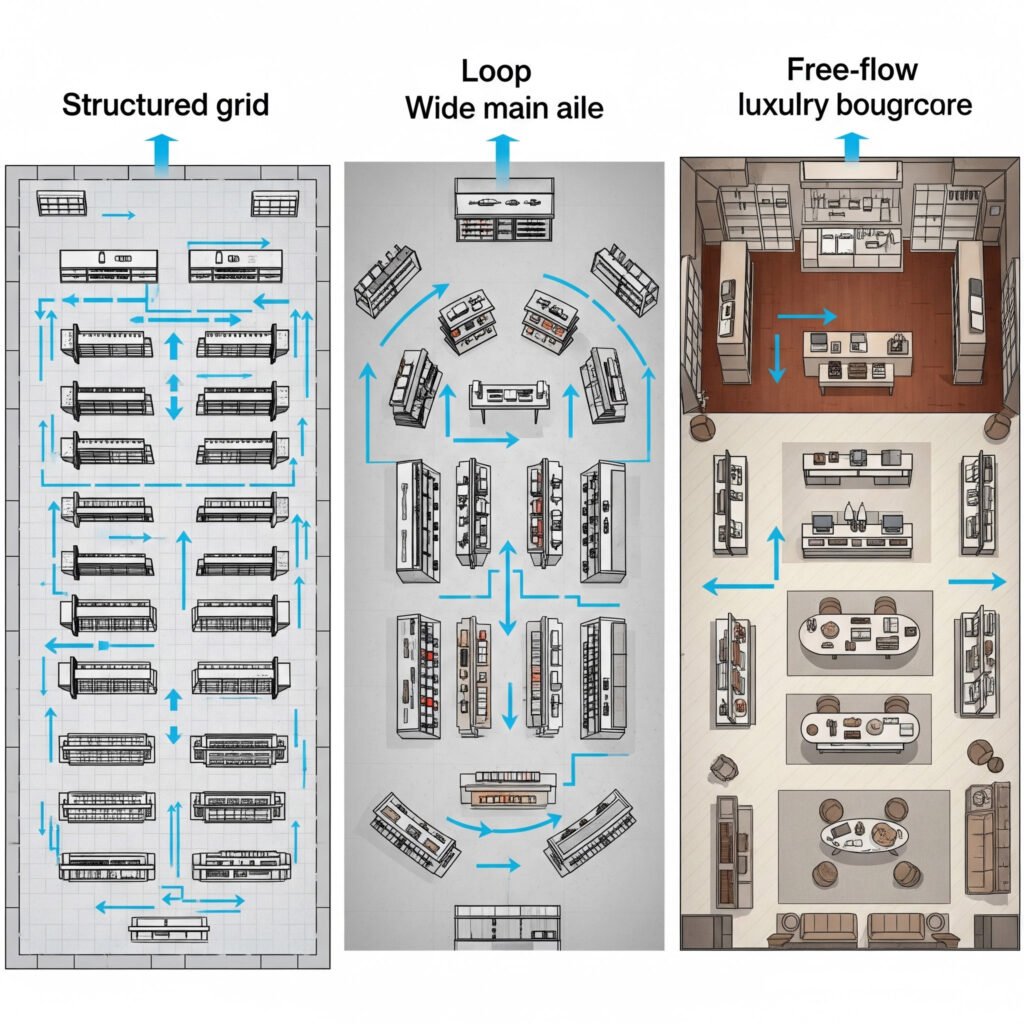Understanding how retail stores display their merchandise helps me design smarter fixtures for my global clients. Every layout tells a sales story. In this article, I’ll share how stores make product presentation work—and how I help them win. Retail stores display their merchandise using shelves, display cases, and slatwall systems to attract buyers, boost visibility.
Table of Contents
ToggleUnderstand Retail Display Basics


Visual Merchandising Creates the First Impression
Shoppers notice the layout first. A well-arranged store makes them feel comfortable. Visual merchandising connects the brand and the buyer instantly. Retailers use placement, lighting, and form to shape buying behavior.
Instead of just placing products, good stores tell stories. Positioning, color contrast, and focal points guide the eye. These elements highlight what matters most. Glass showcases draw attention to key items. Slatwall panels group similar products together. Lighting draws attention to details shoppers might miss otherwise.
Consistency builds trust. Customers feel more confident when a store looks tidy and intentional. Proper spacing, aligned signage, and logical flow influence buying decisions. Clean environments also reduce stress. That alone can keep people browsing longer. Retailers know that more browsing leads to more sales.
Every detail contributes to the first impression. From flooring to fixture color, nothing is accidental. The overall mood must align with the product. That’s why visual merchandising isn’t optional—it’s essential.
Fixtures Define Function and Flow
Display fixtures organize the entire shopping experience. They define how people move and where they stop. When placed correctly, fixtures influence exploration. Good layouts keep people walking longer. Poorly placed fixtures cause traffic jams and frustration.
Each fixture serves a purpose. Freestanding glass showcases present high-value items safely. Slatwall panels offer flexibility for rotating stock. Open shelving allows easy access to everyday items. Stores that combine these smartly appear more professional and better planned.
Material selection matters. E1-grade boards look clean and support green goals. Tempered glass protects products and adds elegance. These materials also reflect quality. Customers can feel the difference between flimsy and sturdy. Their choices are shaped by what they touch and see.
Strong fixtures create structure without crowding. They give retailers full control over product arrangement. Many stores use tiered shelving to show more in less space. Others use wall-mounted units to free up floor space. With the right setup, even small stores can look spacious.
Display Strategy Matches the Store’s Goals
Every store has a unique purpose. Some want fast turnover. Others aim to build brand value. Display strategies must match the goal. That alignment improves customer experience and boosts results.
For high-volume stores, bulk bins and open tables make sense. Customers grab and go. Convenience drives their design. Boutiques, however, focus on mood. They rely on glass counters, soft lighting, and small-group displays to create a boutique feel.
Impulse items often sit near the checkout area. These include snacks, accessories, or limited-time offers. Displays here need easy access and clear signage. For expensive items, security is key. Locking display cases protect products while keeping them visible.
Seasons and trends also shape display strategies. Retailers update layouts often. That helps maintain freshness and relevance. Fixtures need to support these changes. Flexible solutions like modular panels or moveable counters allow fast updates without full redesigns.
Layout Tells a Story
Layout is more than arrangement—it’s storytelling. It leads shoppers on a journey. Where they begin, pause, and end all matter. Strategic layouts increase dwell time and encourage full exploration of the space.
Directional flow helps manage crowd movement. Whether it’s a loop or a grid, there must be logic to the path. Endcap displays, for example, break linear patterns. They catch attention and highlight promotions or new items.
Product grouping reinforces the story. Grouping by type, use, or color makes navigation easier. Clear organization also builds product value. Shoppers associate neat displays with better quality.
Contrast between areas keeps attention fresh. Moving from open spaces to enclosed showcases resets the eye. Transitions like these keep shoppers engaged. They prevent display fatigue.
Smart layouts aren’t rigid. They adapt to shopper behavior. By observing traffic flow, retailers learn where people pause or skip. Those insights guide future fixture placement and product zoning. Every square meter should earn its keep.
Choose the Right Display Types


Glass Showcases Offer Security and Elegance
Many retailers need to protect high-value merchandise while still keeping it visible. That’s where glass showcases play a key role. These units provide a strong visual appeal while preventing theft or damage. From jewelry stores to electronics retailers, glass showcases have become a must-have display solution across industries.
Tempered glass adds a layer of safety and durability. Unlike regular glass, it resists cracks and shattering, even in busy retail environments. The transparency also builds customer trust. Shoppers feel confident when they can view the item clearly before making a decision. That trust often leads to increased sales.
Store owners frequently request lockable units with clean, modern edges. Countertop versions suit small items, while freestanding units accommodate larger products. Both types allow lighting integration to enhance presentation. With proper lighting, even simple products appear premium. These showcases also work well near cash registers, encouraging impulse buys without compromising security.
When asking how retail stores display their merchandise securely, this is one of the top answers. Glass showcases combine function and form. They display items beautifully while keeping them safe. And they adapt easily to many store layouts, whether minimal or dense.
Slatwall Merchandisers Provide Flexibility
In fast-paced retail, flexibility is crucial. Slatwall panels let retailers reconfigure their displays as needed, without replacing entire fixtures. That’s why these panels have become a go-to option for stores selling a variety of products. They support hooks, shelves, bins, and even lighting attachments.
Wall space often goes underused. Slatwalls fix that. By adding vertical display zones, retailers increase usable area without crowding the floor. Customers enjoy the clean, upright design. Products become easier to browse. This approach works especially well in apparel, accessories, tools, or even vape shops.
Retailers can adjust fixture positions daily, weekly, or monthly. Promotions and new arrivals benefit from this adaptability. Swapping out hooks for shelves changes the entire display story. Slatwalls make merchandising more dynamic and cost-efficient. They also allow stores to test what arrangement attracts the most attention.
When wondering how retail stores display their merchandise for fast changeovers, slatwalls offer the perfect solution. From small boutiques to large hardware shops, many rely on them to keep things fresh and well-organized. That’s why Fairwill Display produces them in multiple finishes and board options.
Wooden Counters Deliver Warmth and Versatility
Retailers who want a welcoming atmosphere often choose wooden counters. These fixtures add warmth and a handcrafted appearance. They help balance modern design with a more natural tone. Customers respond well to that blend, especially in boutique environments where emotion drives many purchases.
Wooden counters also serve many purposes. They function as service desks, display islands, or central points of customer interaction. Combining them with tempered glass tops boosts their utility while preserving elegance. The fusion of materials adds contrast, drawing attention to displayed items without overpowering the space.
Custom designs are common. Many clients ask for integrated drawers or hidden storage. Some want LED lighting for added drama. These design features make wooden counters more than just furniture. They become key elements of a brand’s identity inside the store. Displaying merchandise this way enhances storytelling and customer engagement.
Thinking about how do retail stores display their merchandise with character, wooden counters answer that need. They create depth in presentation and connect emotionally with shoppers. At Fairwill Display, E1 grade boards ensure these counters remain eco-friendly while still delivering durability and style.
Organize Based on Product Category


Separate Products by Function
Different functions call for different zones. Placing similar products together makes customer navigation easier. Shoes belong with other shoes, not with shirts or accessories. This grouping method improves clarity and shortens decision time.
Clarity matters more in small stores. With limited floor space, categories keep displays focused. A customer who enters looking for hats shouldn’t stumble into tech gear first. Functional separation reduces confusion. It also helps staff manage restocking and inventory tracking.
Grouping also supports storytelling. A skincare wall might feature cleansers, toners, and moisturizers side by side. This tells a routine-based story. Shoppers follow it naturally. By organizing by function, stores reduce friction. That keeps shoppers focused and more likely to buy.
This method answers one key question: how do retail stores display their merchandise without overwhelming the customer? Functional grouping is the answer. It keeps the store looking organized and makes every square meter work harder.
Balance Between Horizontal and Vertical Space
Too many stores waste vertical space. Walls offer untapped potential. Displaying items at multiple heights catches the eye. This creates visual rhythm. Vertical variation also breaks up large wall areas and makes them feel dynamic.
Placing lighter items higher and heavy ones lower helps with safety. It also improves access. Shelves at eye level work best for best-sellers. High-value products often sit near waist level behind glass for easy viewing. Slatwall panels support this well. They allow flexible hook or shelf placement without needing extra tools.
Horizontal balance still plays a role. Long product lines like books or shoes benefit from clean horizontal runs. In contrast, gift items or small electronics do better with height play. Proper horizontal spacing avoids crowding. Vertical tiers offer depth.
Together, these layers form a balanced visual hierarchy. Shoppers scan upward and downward, not just side to side. How do retail stores display their merchandise to make use of all dimensions? They think in 3D. My clients love how wall-mounted displays and tiered units increase perceived space without adding square footage.
Use Color Blocking and Pattern Cues
Color draws attention faster than text. That’s why stores use color blocking. Arranging similar-colored items side by side guides the eye smoothly. It feels intentional. Color also helps link product sets without obvious signage.
Pattern repetition works the same way. Repeating a label style or package shape strengthens branding. A cosmetics shelf with four identical pink packages feels cohesive. It signals quality and brand unity. That creates confidence in buyers.
Even price tags play a role. Stores use different color tags to highlight deals. A red tag might mean clearance. A yellow one might mark new arrivals. These visual cues reduce the need for staff guidance. They speed up self-navigation.
How do retail stores display their merchandise to create visual harmony? Color and pattern offer that power. Many of my boutique clients prefer this approach over aggressive signage. It’s subtle but effective. It also supports the overall brand identity.
More importantly, these techniques influence emotion. Warm colors encourage impulse buys. Cool tones create calm. That’s why layout planning often starts with a color plan. Every fixture I build considers how lighting and color interact. That helps clients create not just a store—but an experience.
Layout Matters for Sales


Grid Layouts Offer Structure and Efficiency
Most large-format retailers prefer grid layouts for a reason. This structure creates a sense of order and predictability. It encourages quick navigation while maximizing shelf capacity. Customers instinctively follow clean aisle paths, making the experience smooth and familiar.
Retailers can place high-turnover items at the ends of aisles—these are called endcaps. Those spots attract attention and boost impulse purchases. Glass showcases or wood counters placed at the front of each row enhance product visibility while staying organized. This layout works especially well in supermarkets, pharmacies, and hardware stores.
Beyond traffic flow, grid layouts improve employee productivity. Store teams restock items faster and manage inventory with fewer errors. This design ensures every square meter serves a clear purpose. Fixtures must match this efficiency. That’s why we build modular displays that slide into place and adjust without tools. A clean layout saves labor, reduces confusion, and encourages repeat visits.
Loop Layouts Boost Exploration and Engagement
Unlike rigid grids, loop or racetrack layouts guide customers through a full-store journey. This design pulls people along a curved path, exposing them to more product categories. Lifestyle and boutique stores favor this method because it supports discovery.
Strategic placement of new arrivals or seasonal items along the loop increases exposure. Customers often pause longer in loop layouts, especially when lighting, textures, and display height vary along the path. Glass showcases placed at eye level hold attention and add perceived value. These subtle changes build emotional connections with products.
Curved wooden counters also support the loop structure. They soften hard corners and create natural pauses. Merchants report better cross-selling results when using this method. Unlike grid setups, loops promote slower browsing. That means higher average transaction values. Fixtures must match this energy. We design custom shapes that adapt to your space while supporting the loop logic.
Free-Flow Layouts Elevate Product Presence
Some retailers want space to speak. Luxury stores, art galleries, and concept boutiques prefer free-flow layouts. These setups remove visual clutter and focus entirely on product presentation. Every item becomes a feature piece. This strategy works best with fewer, high-value products.
Fixtures play a critical role in this environment. Minimalist glass showcases, single-product risers, and accent lighting work together to elevate perceived worth. Materials matter more in this layout. Tempered glass, polished E1 boards, and hidden hardware define the aesthetic. These touches support a premium in-store feel.
There’s no defined path in free-flow layouts. That encourages browsing freedom. Shoppers explore by intuition. Each display must anchor attention without relying on quantity. A single sculpture, a signature perfume, or a luxury handbag gains more weight when isolated properly. Retailers using this method say customer satisfaction and brand perception improve. To support this, we offer custom low-profile counters and sleek wall units.
Transition Zones Set the First Impression
What happens at the entrance shapes the entire experience. The first five seconds inside a store create a mental map. This is where transition zones matter most. They let customers adjust before diving into product selections.
A calm, open space near the door slows traffic slightly. This gives people a chance to absorb store layout and feel at ease. Bright lighting, minimal clutter, and a statement piece—like a glass display of new arrivals—set the tone. This space must be carefully curated. Overloading it can overwhelm shoppers and reduce engagement.
We often recommend lower counters or feature tables here. Their purpose is to tease rather than sell. Just enough to spark interest. Once inside, the layout—whether grid, loop, or free-flow—can take over. But it all begins at the entrance. If customers feel welcomed and oriented, they stay longer. That extra time often translates to stronger sales.
Why Fairwill Display


Reliable Factory Pricing Without the Middleman
Finding a supplier that balances cost and quality isn’t easy. Many add hidden fees or rely on trading companies. Fairwill Display does it differently. They own their factory. That means no middleman markups.
As a wholesaler, I need competitive pricing to protect my margins. Fairwill gives me just that. Their quotes arrive fast and clearly broken down. No guesswork. No confusion.
I’ve compared prices across China and beyond. Fairwill Display consistently offers 20% to 30% lower pricing on bulk glass showcases and slatwall fixtures. Even better, I don’t have to compromise on materials. They use E1-grade boards and thick tempered glass, even at budget levels.
Bulk orders also get professional packaging. My shipments arrive clean and ready for the floor. In retail, that kind of consistency matters. It saves me time. It protects my investment.
Professional Design Guidance That Converts
Display cases do more than just hold products. They sell. Layout, materials, and size affect how customers buy. That’s where Fairwill Display stands out. They don’t just manufacture—they consult.
When I wasn’t sure how to present new vape products, they shared sample store layouts. They explained how glass height and lighting angles could guide buyer behavior. Their advice worked. Sales went up 18% within a month of rearranging.
They help me match display types to my goals. Need lockable glass for jewelry? They have it. Want flexible slatwalls for seasonal goods? They recommend panel heights and accessories. They treat my problems like their own.
Even small orders get expert input. That’s rare. Many suppliers only care about volume. Fairwill cares about results.
Fast Global Export and Real-Time Communication
I ship to multiple countries. That makes customs, lead times, and documentation important. Fairwill Display handles that with ease. They’ve shipped to the USA, Sweden, and Australia for years.
I receive full export documents in advance. That speeds up customs. Their packaging is rock-solid. Not once have I received broken glass or damaged boards. That level of care matters, especially across oceans.
When I message them, they reply fast. Emails don’t sit unread. I get answers within a day—often in just hours. That helps me update my clients and plan deliveries.
Fairwill’s shipping team knows how to load containers properly. No wasted space. No risky stacking. They treat my cargo like their own brand depends on it. And it does.
Customization, Quality Control, and Long-Term Value
My business needs to change. Sometimes I need narrow glass cases. Sometimes I need wider slatwalls. Fairwill builds both—and more. Their team adjusts dimensions, finishes, and lighting styles.
Before anything ships, they send photos. They show packing methods, screw sets, even the inside of drawers. That kind of QC builds trust. I don’t have to wonder if what I ordered matches what I’ll receive.
They also improve designs when needed. One time, they upgraded my cabinet’s ventilation slots without me asking. It solved a problem I didn’t even know I had. That attention to detail turns a one-time order into a long-term relationship.
Let’s Work Together
If you’re tired of middlemen, unclear answers, or weak packaging, Fairwill Display is your solution. They offer direct factory pricing, expert guidance, and global shipping support. Most of all, they listen.
Fairwill Display doesn’t just ship display cases. They help wholesalers grow. If you’re ready to upgrade your fixtures and simplify your supply chain—send them an inquiry today. The support starts from day one.
